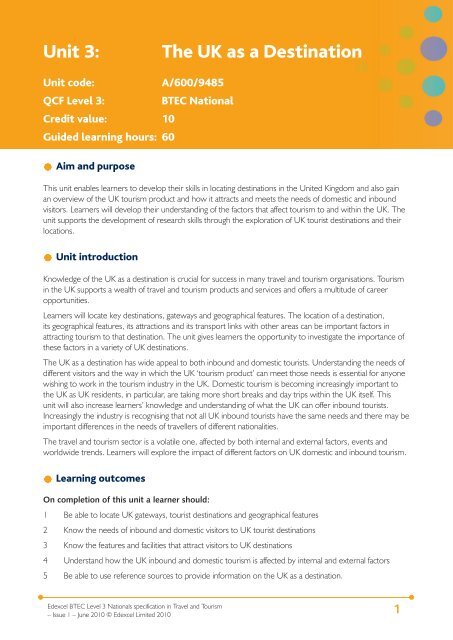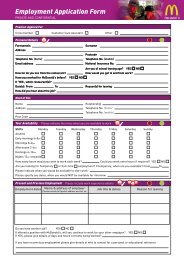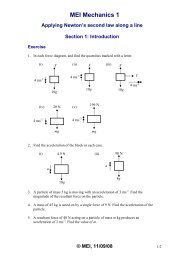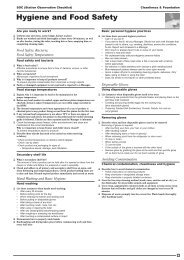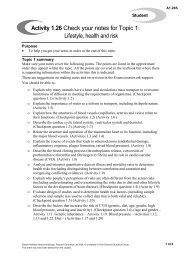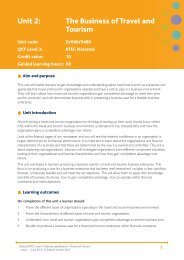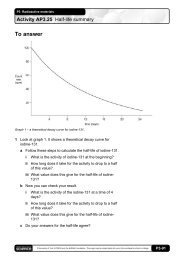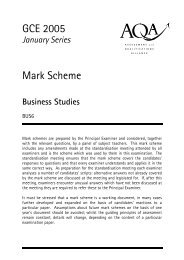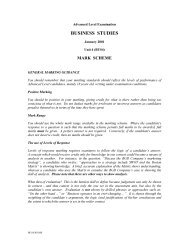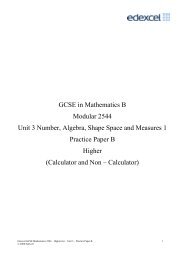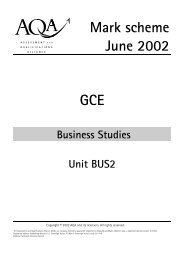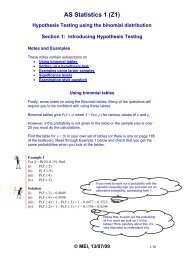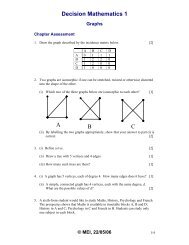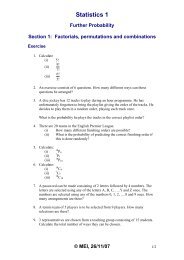Unit 3: The UK as a Destination
Unit 3: The UK as a Destination
Unit 3: The UK as a Destination
You also want an ePaper? Increase the reach of your titles
YUMPU automatically turns print PDFs into web optimized ePapers that Google loves.
<strong>Unit</strong> 3:<strong>The</strong> <strong>UK</strong> <strong>as</strong> a <strong>Destination</strong><strong>Unit</strong> code:QCF Level 3:Credit value: 10Guided learning hours: 60Aim and purposeA/600/9485BTEC NationalThis unit enables learners to develop their skills in locating destinations in the <strong>Unit</strong>ed Kingdom and also gainan overview of the <strong>UK</strong> tourism product and how it attracts and meets the needs of domestic and inboundvisitors. Learners will develop their understanding of the factors that affect tourism to and within the <strong>UK</strong>. <strong>The</strong>unit supports the development of research skills through the exploration of <strong>UK</strong> tourist destinations and theirlocations.<strong>Unit</strong> introductionKnowledge of the <strong>UK</strong> <strong>as</strong> a destination is crucial for success in many travel and tourism organisations. Tourismin the <strong>UK</strong> supports a wealth of travel and tourism products and services and offers a multitude of careeropportunities.Learners will locate key destinations, gateways and geographical features. <strong>The</strong> location of a destination,its geographical features, its attractions and its transport links with other are<strong>as</strong> can be important factors inattracting tourism to that destination. <strong>The</strong> unit gives learners the opportunity to investigate the importance ofthese factors in a variety of <strong>UK</strong> destinations.<strong>The</strong> <strong>UK</strong> <strong>as</strong> a destination h<strong>as</strong> wide appeal to both inbound and domestic tourists. Understanding the needs ofdifferent visitors and the way in which the <strong>UK</strong> ‘tourism product’ can meet those needs is essential for anyonewishing to work in the tourism industry in the <strong>UK</strong>. Domestic tourism is becoming incre<strong>as</strong>ingly important tothe <strong>UK</strong> <strong>as</strong> <strong>UK</strong> residents, in particular, are taking more short breaks and day trips within the <strong>UK</strong> itself. Thisunit will also incre<strong>as</strong>e learners’ knowledge and understanding of what the <strong>UK</strong> can offer inbound tourists.Incre<strong>as</strong>ingly the industry is recognising that not all <strong>UK</strong> inbound tourists have the same needs and there may beimportant differences in the needs of travellers of different nationalities.<strong>The</strong> travel and tourism sector is a volatile one, affected by both internal and external factors, events andworldwide trends. Learners will explore the impact of different factors on <strong>UK</strong> domestic and inbound tourism.Learning outcomesOn completion of this unit a learner should:1 Be able to locate <strong>UK</strong> gateways, tourist destinations and geographical features2 Know the needs of inbound and domestic visitors to <strong>UK</strong> tourist destinations3 Know the features and facilities that attract visitors to <strong>UK</strong> destinations4 Understand how the <strong>UK</strong> inbound and domestic tourism is affected by internal and external factors5 Be able to use reference sources to provide information on the <strong>UK</strong> <strong>as</strong> a destination.Edexcel BTEC Level 3 Nationals specification in Travel and Tourism– Issue 1 – June 2010 © Edexcel Limited 20101
<strong>Unit</strong> content1 Be able to locate <strong>UK</strong> gateways, tourist destinations and geographical featuresGateways: <strong>UK</strong> airports (international, regional); identification of three-letter-codes; p<strong>as</strong>senger seaports egDover, Larne, Holyhead; Channel Tunnel terminiTourist destinations: capital cities (Belf<strong>as</strong>t, Cardiff, Edinburgh, London); co<strong>as</strong>tal resorts eg Brighton,Blackpool; cultural or historical towns and cities eg Bath, Liverpool; countryside are<strong>as</strong> eg Lake District,SnowdoniaGeographical features: rivers; mountain ranges and upland are<strong>as</strong> eg Pennines; islands eg Arran, Isle ofWight; bodies of water eg Loch Ness, Windermere; woodland are<strong>as</strong> and forests eg Epping Forest,Sherwood Forest2 Know the needs of inbound and domestic visitors to <strong>UK</strong> tourist destinationsInbound: different nationalities eg French, Chinese, UAE; differing motivationsDomestic: differing motivations; different types of visits eg for day trips, short breaks, longer stay holidaysNeeds: access to information eg brochures, internet; accommodation range, cost and standards; transporteg rail, road, air gateways, car hire, ferries, local transport; accessibility eg mobility, families; customerservice eg Welcome Host, Welcome All, language; value for money; activities eg sightseeing, cultural/heritage experiences, shopping, eating out, sport, educational, entertainment, nightlife, relaxation, walking,leisure pursuits, special interests; relating to differing ages; relating to differing cultures; relating to differingmotivations3 Know the features and facilities that attract visitors to <strong>UK</strong> destinations<strong>UK</strong> destinations: eg capital cities, co<strong>as</strong>tal resorts, cultural or historical towns and cities, countryside are<strong>as</strong>Location: accessibility eg by road, rail, air, seaNatural features: eg beaches, rivers, mountains, gorges, waterfallsBuilt attractions: eg c<strong>as</strong>tles, museums, historic houses, theme parks, cathedralsFacilities: range of accommodation; eating out; sport and leisure; entertainment; shopping; local transportwithin destinationOther features: eg themed destinations, media influences, famous people, royalty, events, novelty, localcustoms and traditionsVisitors: domestic; inbound; differing motivations eg history, culture, relaxation, sport, special occ<strong>as</strong>ion,educational, entertainment, business, special interest; differing ages; differing sizes or types of parties egsingles, couples, families, groups2Edexcel BTEC Level 3 Nationals specification in Travel and Tourism– Issue 1 – June 2010 © Edexcel Limited 2010
4 Understand how the <strong>UK</strong> inbound and domestic tourism is affected by internal andexternal factorsFactors: internal and external eg health, safety and security within the <strong>UK</strong>, accessibility, marketingcampaigns, availability of products and services, quality of goods and services, economic recession in<strong>UK</strong> and/or tourist generating countries, exchange rates, travel restrictions, emergence of new markets,competition from other destinations, weatherEffects: eg changes in visitor numbers, length of stay, volume and value of inbound and domestic tourism,frequency of visits, generating countries and regions5 Be able to use reference sources to provide information on the <strong>UK</strong> <strong>as</strong> a destinationReference sources: atl<strong>as</strong>es; internet; brochures; statistical data; timetables; destination guides; other sourceseg travel trade press, newspaper reports, TV programmesEdexcel BTEC Level 3 Nationals specification in Travel and Tourism– Issue 1 – June 2010 © Edexcel Limited 20103
Assessment and grading criteriaIn order to p<strong>as</strong>s this unit, the evidence that the learner presents for <strong>as</strong>sessment needs to demonstrate thatthey can meet all the learning outcomes for the unit. <strong>The</strong> <strong>as</strong>sessment criteria for a p<strong>as</strong>s grade describe thelevel of achievement required to p<strong>as</strong>s this unit.Assessment and grading criteriaTo achieve a p<strong>as</strong>s grade theevidence must show that thelearner is able to:P1P2P3P4P5locate gateways, touristdestinations and geographicalfeatures of the <strong>UK</strong> withoutthe use of reference materialsdescribe the needs ofinbound and domestic visitorsto <strong>UK</strong> destinationsdescribe the features andfacilities that attract visitors tothree <strong>UK</strong> destinations [IE 2]explain how internal andexternal factors affect <strong>UK</strong>inbound and domestictourismuse appropriate referencesources to provideinformation on the <strong>UK</strong> <strong>as</strong> adestination.To achieve a merit grade theevidence must show that, inaddition to the p<strong>as</strong>s criteria,the learner is able to:M1 analyse how one <strong>UK</strong>destination attracts inboundand domestic visitors andmeets their needsM2 analyse how three factorsare currently affecting <strong>UK</strong>inbound and domestictourism.To achieve a distinction gradethe evidence must show that,in addition to the p<strong>as</strong>s andmerit criteria, the learner isable to:D1D2evaluate the effectivenessof one <strong>UK</strong> destination inattracting and meetingthe needs of inboundand domestic visitors,making recommendationsfor addressing gaps orweaknesses in provisionevaluate the potential impactsof two factors on the futureof <strong>UK</strong> inbound and domestictourism.PLTS: This summary references where applicable, in the square brackets, the elements of the personal,learning and thinking skills applicable in the p<strong>as</strong>s criteria. It identifies opportunities for learners to demonstrateeffective application of the referenced elements of the skills.KeyIE – independent enquirersRL – reflective learnersSM – self-managersCT – creative thinkersTW – team workersEP – effective participators4Edexcel BTEC Level 3 Nationals specification in Travel and Tourism– Issue 1 – June 2010 © Edexcel Limited 2010
Essential guidance for tutorsDeliveryThis unit gives learners an overview of the <strong>UK</strong> tourism product, its customers and the factors that affecttourism to and within the <strong>UK</strong>. It supports the development of research skills through the exploration of traveldestinations.Tutors should ensure that learners use a wide variety of information sources in order to avoid over-relianceon one specific source. Learners should be guided to sources such <strong>as</strong> atl<strong>as</strong>es, brochures, destination guidesand websites and should be encouraged to read newspapers, especially the travel supplements, and to watchtravel programmes.A good starting point for the unit is to find out learners’ experiences of tourism in the <strong>UK</strong> <strong>as</strong> these are oftenlimited. Different types of destinations, gateways and geographical features may be identified in this way.Knowledge of the geography of the <strong>UK</strong> forms the b<strong>as</strong>is of this unit and it is essential for those learnersintending to work in the travel and tourism industry. It is important that learners are able to locate the maingateways, tourist destinations and geographical features of the <strong>UK</strong> without access to reference material.Learners could locate the requisite geographical and other features on a series of maps with the help ofsources of information such <strong>as</strong> atl<strong>as</strong>es, but should then be tested on their knowledge without access to thesesources. Tests and quizzes can be used periodically to support learning and to prepare for <strong>as</strong>sessment. <strong>The</strong>secan be set up in teams in a competitive way to encourage active participation. DVDs on different destinationsshould be shown regularly to add visual interest.Visits will form an important part of this unit and should be facilitated where possible in the form of day tripsand residential visits. Specific links can be made with <strong>Unit</strong> 19: <strong>UK</strong> Visitor Attractions and <strong>Unit</strong> 23: ResidentialStudy Visit in Travel and Tourism. While visiting destinations they could undertake research to completeworksheets on facilities and features, and carry out surveys to find out about visitor motivations.It is important that learners understand the meaning of both inbound and domestic tourism. Learners shouldalso understand that different types of visitors have specific needs and different motivations when visiting adestination. To understand the needs of different types of visitor, learners could start by considering theirown needs when on holiday in this country and when abroad. This could be followed by a group discussion,highlighting the similarities and differences in learners’ needs. Learners could then discuss the needs ofdifferent types of domestic tourism markets, eg the elderly, families and groups when travelling for differentmotivations.When considering <strong>UK</strong> inbound tourism, learners should understand that, <strong>as</strong> well <strong>as</strong> having certain needsin common, there are significant differences between different nationalities. This could be introduced bytutor input or by researching the profiles of different nationalities. Groups of learners could each be given anationality to research and the groups could share this information with each other. <strong>The</strong> VisitBritain Industrywebsite is an excellent source of information regarding the profiles of different nationalities and to identify theirdiffering needs and expectations when they visit the <strong>UK</strong>.<strong>The</strong> full range of ‘needs’ should be addressed in cl<strong>as</strong>s, to highlight common needs, also differentiatingbetween inbound and domestic visitors, and also where needs might be affected by length of stay or differingmotivations.Edexcel BTEC Level 3 Nationals specification in Travel and Tourism– Issue 1 – June 2010 © Edexcel Limited 20105
Learners should be encouraged to use a wide range of reference materials in order to explore why certain<strong>UK</strong> destinations are able to attract various inbound and domestic visitors. Learners should understand thatthe location of a destination, its natural features, accessibility, facilities and attractions can all play a vital role inencouraging tourism to a destination. A c<strong>as</strong>e study of a particular destination could be investigated. All learnerscould study the same destination in cl<strong>as</strong>s and use a variety of sources to determine how its location, naturalfeatures and facilities, accessibility and attractions could encourage tourism. Learners could then choosedestinations of their own which may be submitted <strong>as</strong> evidence for <strong>as</strong>sessment. If learners find it difficult tochoose appropriate destinations, the tutor could supply a list of destinations from which learners can choose.Identifying factors affecting <strong>UK</strong> domestic and inbound tourism should be an interesting area for investigation.This unit requires learners to use tourism statistics correctly in order to identify significant <strong>as</strong>pects of <strong>UK</strong>inbound and domestic tourism. Statistics used should be current, ie from within the l<strong>as</strong>t five years. <strong>The</strong>Star<strong>UK</strong>, VisitBritain and Office for National Statistics websites are useful sources of up-to-date statistics. It isimportant that learners not only identify relevant sources of data but are also able to interpret them accuratelyto find information such <strong>as</strong> the number of inbound and domestic tourists that the <strong>UK</strong> receives each year, theamount of income generated by inbound and domestic tourism, average length of stay, countries and regionsof origin, and purpose of visit. This may mean that learners are required to have an input into how to analysestatistics or that they be given the opportunity to develop appropriate skills.This unit also requires learners to investigate the external and internal factors affecting tourism to and withinthe <strong>UK</strong> today. Learners should have a clear understanding of the difference between internal (occurring inthe <strong>UK</strong>) and external (occurring outside the <strong>UK</strong>) factors and the ways in which factors can encourage ordiscourage <strong>UK</strong> inbound and domestic tourism. This could be introduced by tutor input but learners shouldthen be encouraged to read newspapers, travel trade publications and other media reports and note anysignificant factors which could affect the <strong>UK</strong> tourism industry. <strong>The</strong>se factors can include the impact of theweather and how a dismal, rainy summer can impact on domestic tourism the following year, how goodweather can stimulate domestic bookings and l<strong>as</strong>t minute breaks but will have less impact on inbound visitors.Inbound and domestic visitor numbers can be affected by changes in exchange rates, <strong>as</strong> holidaying in the <strong>UK</strong>can incre<strong>as</strong>e in popularity when the pound is weak. Other factors could include the effect of terrorist activities,growth of budget airlines and their subsequent incre<strong>as</strong>e in the carriage of inbound visitors from a wide rangeof destinations, and competition from other countries. <strong>The</strong>se, and other topical factors, could form theb<strong>as</strong>is for regular group discussions. Learners could compile individual portfolios of all the factors affecting <strong>UK</strong>tourism during delivery of the unit and could use this to aid their <strong>as</strong>sessment. Comprehensive records shouldbe kept of all sources used.6Edexcel BTEC Level 3 Nationals specification in Travel and Tourism– Issue 1 – June 2010 © Edexcel Limited 2010
Outline learning plan<strong>The</strong> outline learning plan h<strong>as</strong> been included in this unit <strong>as</strong> guidance and can be used in conjunction with theprogramme of suggested <strong>as</strong>signments.<strong>The</strong> outline learning plan demonstrates one way of planning the delivery and <strong>as</strong>sessment of this unit.Topic and suggested <strong>as</strong>signments/activities and/<strong>as</strong>sessmentIntroduction to the unit and <strong>as</strong>sessment planHow to make up a portfolio of newspaper features etc of topics relevant to factors affecting inbound anddomestic tourism (Preparation for Assignment 3)Discussion on knowledge of <strong>UK</strong> <strong>as</strong> a destination, places visited etcTeam quizIntroduction to different sources of information, referencing work, bibliography etc. Worksheet to practise usingdifferent sources; link to P5DVD on <strong>UK</strong> destinationsIntroduction to Assignment 1Paired work using resources to locate <strong>UK</strong> p<strong>as</strong>senger ports and Channel Tunnel terminiPractice test to locate four <strong>UK</strong> p<strong>as</strong>senger ports and two <strong>UK</strong> Channel Tunnel termini without using resourcesPaired work using resources to locate international and regional airports, with 3 letter codesPractice test to locate four international and regional airports, giving codes, without using resourcesSmall-group work to use holiday brochures and atl<strong>as</strong>es to locate capitals, tourist destinations, gateways andgeographical features in different regionsDisplay regional mapsPractice test to locate capital cities without using resourcesAssignment 1: Around the <strong>UK</strong> (P1) – test (gateways, and capital cities, without usingresources)Feedback on <strong>as</strong>sessmentPicture quiz – well-known co<strong>as</strong>tal resorts, cultural towns/cities, countryside are<strong>as</strong>Use cl<strong>as</strong>s display map to locateWord search – named geographical featuresUse cl<strong>as</strong>s display map to locateTeam quiz – Where am I?Practice test to locate tourist destinations and geographical features without using resourcesAssignment 1: Around the <strong>UK</strong> (tourist destinations and geographical features, without usingresources – test for P1)Feedback on <strong>as</strong>sessmentIntroduction to Assignment 2Discussion on own needs on holidaySmall-group work to discuss the needs of different types of domestic tourist markets, eg the elderly, families,groups when travelling for different motivationsShare findings – link to unit contentEdexcel BTEC Level 3 Nationals specification in Travel and Tourism– Issue 1 – June 2010 © Edexcel Limited 20107
Topic and suggested <strong>as</strong>signments/activities and/<strong>as</strong>sessmentWorking in pairs using VisitBritain reports to make up profile of different nationalities and their needs in the <strong>UK</strong>Produce postersShare with cl<strong>as</strong>sDiscuss similarities and differences – link to unit contentIndividual research for Assignment 2: part AAssignment 2: <strong>Destination</strong> <strong>UK</strong> (P2, part P5)Feedback on <strong>as</strong>sessmentPrepare worksheet for visit to <strong>as</strong>sist research into features and facilities of a local tourist destination – link toinbound and domestic visitor needs, different ages and motivationsFact finding visit to a local tourist destination and/or guest speakerReview visit and findingsDiscuss different features and facilities and how they attract visitorsIdentification of any gaps in provisionDVD on co<strong>as</strong>tal destinationWorking in pairs to research features and facilities of a co<strong>as</strong>tal destinationProduce posterDiscussion and comparison of different co<strong>as</strong>tal destinations and their appeal for different inbound and domesticvisitorsIdentification of any gaps in provisionDVD on countryside areaWorking in small groups to research different countryside are<strong>as</strong>Short presentationsDiscussion and comparison of different countryside are<strong>as</strong> and their appeal for different inbound and domesticvisitorsIdentification of any gaps in provisionDVD on cultural/historical destinationsPen portraits to select cultural/historical towns/cities to meet visitor needsCompare findings in small groupsLiverpool c<strong>as</strong>e studyDiscussion on good practices and gaps in provisionSelecting destinations for part BIndividual research for Assignment 2: part BAssignment 2: <strong>Destination</strong> <strong>UK</strong> (P3, M1, D1, part P5)Feedback on <strong>as</strong>sessmentIntroduction to Assignment 3Accessing statistical data – worksheets b<strong>as</strong>ed on Star<strong>UK</strong> and VisitBritainObtaining statistics on visitor numbers, length of stay, volume and value of inbound and domestic tourismDiscuss findings. Check understanding8Edexcel BTEC Level 3 Nationals specification in Travel and Tourism– Issue 1 – June 2010 © Edexcel Limited 2010
Topic and suggested <strong>as</strong>signments/activities and/<strong>as</strong>sessmentReview of marketing campaignsDiscuss impact on inbound and domestic tourismResearching articles and sourcing information on different factors – individual workMaking short presentation to share findingsResearch and debate on the impact of low-cost airlines on inbound and domestic tourismReviewing portfolio for materials for <strong>as</strong>sessmentAdditional research on selected factorsAssignment 3: Challenging Times (P4, M2, D2, part P5)Feedback on <strong>as</strong>sessment and unit reviewAssessment<strong>The</strong> <strong>as</strong>sessment criteria can be grouped together to enable learners to expand on one criterion in order togain higher grades. <strong>The</strong> links are <strong>as</strong> follows: P1; P2, P3, M1 and D1; P4, M2 and D2; P5. Where possible,learners should be encouraged and given the opportunity to meet the relevant higher grading opportunities atthe same time <strong>as</strong> they attempt the appropriate p<strong>as</strong>s criteria.Centres should design their <strong>as</strong>sessment strategies to meet a range of individual needs and the local workenvironment. Assessment should encourage the learners to apply knowledge gained from this unit and reflecton understanding gained from other units.P1For P1, a series of blank maps of the <strong>UK</strong> should be provided. Without access to reference materials learnersmust accurately locate:●●●●●●capital cities (London, Cardiff, Belf<strong>as</strong>t and Edinburgh)six co<strong>as</strong>tal resortssix historical or cultural towns or citiesfour countryside are<strong>as</strong>two examples each of different geographical features that attract tourists, ie rivers, mountain ranges orupland are<strong>as</strong>, islands, bodies of water, woodland are<strong>as</strong> or forestsfour <strong>UK</strong> p<strong>as</strong>senger seaports.None of the above locations can be duplicated for the purposes of the <strong>as</strong>sessment.Learners should also accurately locate:●●four international <strong>UK</strong> airports with their 3-letter codestwo <strong>UK</strong> termini serving the Channel Tunnel.P1 could be achieved through a series of short tests given at regular intervals throughout the delivery ofthe unit. Access to resources must not be available to the learner during the <strong>as</strong>sessments. Evidence shouldbe supported by witness statements, signed and dated by both <strong>as</strong>sessor and learner to confirm that the<strong>as</strong>sessment h<strong>as</strong> been carried out independently without access to resources.Edexcel BTEC Level 3 Nationals specification in Travel and Tourism– Issue 1 – June 2010 © Edexcel Limited 20109
P2 – P3 – M1 – D1For P2, learners must describe the needs of inbound and domestic visitors to <strong>UK</strong> destinations. For thepurposes of <strong>as</strong>sessment learners should select two inbound visitors of two different nationalities and twodiffering motivations, eg a couple from China who wish to visit all the capitals of the <strong>UK</strong> and a group ofstudents from the USA who are attending a sporting event, plus two different types of domestic visitorswith different motivations, eg a family with young children wanting a day visit to a theme park, and a retiredcouple who want a week’s stay in a city. <strong>The</strong> full range from the unit content must be addressed for each typeof visitor (ie four) in terms of access to information, accommodation range, cost and standards, transport,accessibility, customer service, value for money and activities. This can be a broad description but it must besupported by examples relating to destinations. It is recommended that tutors provide pen portraits of thetypes of visitors.For P3, learners must select one co<strong>as</strong>tal resort, one countryside area and one historical or cultural town orcity. Learners should take care when selecting destinations to make sure one will be suitable for workingtowards M1 and D1. For each destination selected they must describe the location and accessibility, naturalfeatures, built attractions, facilities (range of accommodation, eating out, sport and leisure, entertainment,shopping, local transport options) and other features, eg local customs and traditions, in relation to how theyattract different types of visitors. Some <strong>as</strong>pects such <strong>as</strong> built attractions might attract most types of visitors,but where particular features or facilities have specific appeal for a type of visitor, this should be stated. Bothdomestic and inbound visitors should be included for each destination. Differing motivations, ages and size ortypes of parties should be referred to across the evidence <strong>as</strong> a whole, ie across the three destinations.To achieve M1, learners must now analyse how one of the destinations from P3 attracts inbound anddomestic visitors and meets their needs. <strong>The</strong> selection of destination is important. For example, a citydestination like Liverpool will allow scope to address its attraction for domestic visitors such <strong>as</strong> family groups,school groups, hen parties and stag groups, particularly on short breaks or day trips. It h<strong>as</strong> cultural appeal <strong>as</strong>City of Culture in 2008 and would attract both inbound visitors and domestic visitors interested in musicalculture including the Beatles, or maritime history etc. Learners may focus their analysis for M1 on at le<strong>as</strong>t fourdifferent types of visitors <strong>as</strong> long <strong>as</strong> this includes both inbound and domestic with differing needs – for examplea <strong>UK</strong> family on budget short break, young Japanese tourists with an interest in shopping and music, olderpeople on a day trip, American tourists interested in Liverpool’s maritime history and culture.For D1, learners must now make some judgements on the effectiveness of the selected destination inattracting inbound and domestic visitors and meeting their needs. Specific qualities of the destinations shouldbe noted and recommendations for the future should be made to address any gaps or weaknesses inprovision. This can be a progression from the analysis carried out for M1.P4 – M2 – D2For P4, learners must demonstrate their understanding of different factors that affect <strong>UK</strong> inbound anddomestic tourism. <strong>The</strong> effects must be explained, for example how terrorist activities can result indisinclination to travel, cancelled holidays and consequently changes in visitor numbers. Learners should usehard evidence in the form of recent statistical data (ie over the l<strong>as</strong>t five years) to support their explanations ofthe effect of at le<strong>as</strong>t five different factors on inbound and/or domestic tourism. Both inbound and domestictourism must be addressed within the evidence <strong>as</strong> a whole. Evidence could be presented <strong>as</strong> an informalreport or presentation which includes an interpretation of statistical information given in various formats such<strong>as</strong> tables, graphs and pie charts.Presentations must be supported by detailed observation records confirming exactly how specific criteria havebeen achieved. <strong>The</strong>y should be further supported by notes, PowerPoint slides, handouts etc.10Edexcel BTEC Level 3 Nationals specification in Travel and Tourism– Issue 1 – June 2010 © Edexcel Limited 2010
M2 requires learners to analyse how three factors are affecting <strong>UK</strong> inbound and domestic tourism today.Both inbound and domestic tourism markets must be addressed within the evidence <strong>as</strong> a whole, but notnecessarily both markets for each factor. An interesting way of achieving M2 would be to build up a portfoliooutlining the factors that affect the <strong>UK</strong> during the delivery of the unit. Information for the portfolio couldbe gained from a variety of sources, such <strong>as</strong> media reports, industry publications and relevant websites.<strong>The</strong> portfolio could then be used <strong>as</strong> the b<strong>as</strong>is for analysing three key factors. Learners should choose thethree factors carefully in order that two could be selected to support D2. It is not possible to give firmrecommendations for the types of factors to include <strong>as</strong> these must be current for M2, ie within the l<strong>as</strong>t year.For D2, learners are required to evaluate the potential impact of two factors on the future of <strong>UK</strong> inbound anddomestic tourism. Learners must take a minimum of two of the three factors that formed the b<strong>as</strong>is of analysisfor M2 and evaluate the potential impact of these. One example of a response at this level might be to referto the global economic crunch and evaluate the potential impacts of a slow rate of recovery either in the <strong>UK</strong>or in key inbound tourism markets.P5P5 will be evidenced through the unit <strong>as</strong>sessments for learning outcomes 2, 3 and 4. Assessment evidencemust include a varied range of relevant information sources including atl<strong>as</strong>es, the internet, brochures, statisticaldata, timetables, destination guides and any other sources, eg trade press. In order to achieve P5, learners’work should be well sourced and bibliographies should be provided giving clear details of reference materialsused, and making sure that the full range h<strong>as</strong> been addressed across the unit <strong>as</strong> a whole.Programme of suggested <strong>as</strong>signments<strong>The</strong> table below shows a programme of suggested <strong>as</strong>signments that cover the p<strong>as</strong>s, merit and distinctioncriteria in the <strong>as</strong>sessment and grading grid. This is for guidance and it is recommended that centres eitherwrite their own <strong>as</strong>signments or adapt any Edexcel <strong>as</strong>signments to meet local needs and resources.Criteria covered Assignment title Scenario Assessment methodP1Assignment 1: Around the<strong>UK</strong>Working for an inboundand domestic touroperator. End of trainingtest to accuratelylocate <strong>UK</strong> destinations,geographical features,gateways.Test – map work withoutusing resourcesP2, P3, M1, D1(part P5)Assignment 2: <strong>Destination</strong><strong>UK</strong>Working for a <strong>UK</strong> b<strong>as</strong>edinbound and domestictour operator. Review ofthe needs of inbound anddomestic visitors and anillustrated report on thefacilities and features thatattract visitors to threedestinations. Analysisof how one destinationmeets differing needs andidentification of gaps inprovision.Written review andillustrated reportDetailed bibliographyEdexcel BTEC Level 3 Nationals specification in Travel and Tourism– Issue 1 – June 2010 © Edexcel Limited 201011
Criteria covered Assignment title Scenario Assessment methodP4, M2D2(part P5)Assignment 3: ChallengingTimesWorking for a <strong>UK</strong> b<strong>as</strong>edinbound and domestictour operator –educational talk to collegestudents; review of factorsaffecting <strong>UK</strong> inbound anddomestic markets andpotential impactsPresentation to collegestudentsDetailed bibliographyLinks to National Occupational Standards, other BTEC units, other BTECqualifications and other relevant units and qualificationsThis unit forms part of the BTEC travel and tourism sector suite. This unit h<strong>as</strong> particular links with:Level 2 Level 3<strong>The</strong> Travellers’ World<strong>UK</strong> Tourism <strong>Destination</strong>sInvestigating the Travel and Tourism SectorMarketing Travel and Tourism Products and ServicesSpecialist TourismP<strong>as</strong>senger Transport for Travel and TourismTourism in Rural Are<strong>as</strong><strong>UK</strong> Visitor AttractionsResidential Study Visit in Travel and TourismEssential resourcesLearners should have access to a library/resource centre and the internet, <strong>as</strong> well <strong>as</strong> atl<strong>as</strong>es and factual andpromotional material produced by organisations involved in <strong>UK</strong> inbound and domestic tourism.Employer engagement and vocational contextsVisits to <strong>UK</strong> destinations and talks from tourism officers in destinations will support delivery of the unit.Indicative reading for learnersTextbooksBTEC First Travel Atl<strong>as</strong> <strong>UK</strong> and Europe Edition (Columbus Travel Publishing/Edexcel Ltd, 2006)ISBN 1846900050Dale G – BTEC Level 3 National Travel and Tourism Student Book 1 (Pearson, 2010) ISBN 9781846907272Dale G – BTEC Level 3 National Travel and Tourism Student Book 2 (Pearson, 2010) ISBN 9781846907289Dale G, Kelly M, King C and Jefferies M – BTEC Level 3 National Travel and Tourism Teaching Resource Pack(Pearson, 2010) ISBN 9781846907296James E, Thirlaway J and Woodhouse U – BTEC National in Travel and Tourism (Hodder Education, 2007)ISBN 978034094573512Edexcel BTEC Level 3 Nationals specification in Travel and Tourism– Issue 1 – June 2010 © Edexcel Limited 2010
WebsitesDCMSEnglish HeritageEnjoy EnglandExamples of destination tourism sitesExamples of regional tourist boardsInbound tourism profilesNational Statistics OnlineNorthern Ireland Tourist BoardStar <strong>UK</strong> – statistics on tourism research<strong>The</strong> National Trust<strong>The</strong> National Trust for Scotland<strong>UK</strong> Experience (<strong>UK</strong> holiday brochures)<strong>UK</strong> InboundVisit BritainVisit ScotlandVisit Waleswww.culturegov.ukwww.staruk.org.uk/www.english-heritage.org.ukwww.enjoyengland.comwww.peakdistrictonline.co.ukwww.skegness-resort.co.ukwww.stratford-upon-avon.co.ukwww.visitsouthwest.co.ukwww.yorkshire.comwww.tourismtrade.org.ukwww.statistics.gov.ukwww.nitb.comwww.star<strong>UK</strong>.org.ukwww.nationaltrust.org.ukwww.nts.org.ukwww.theukexperience.comww.ukinbound.co.ukwww.visitbritain.co.ukwww.visitscotland.comwww.VisitWales.co.ukEdexcel BTEC Level 3 Nationals specification in Travel and Tourism– Issue 1 – June 2010 © Edexcel Limited 201013
Delivery of personal, learning and thinking skills (PLTS)<strong>The</strong> table below identifies the personal, learning and thinking skills (PLTS) that have been included within thep<strong>as</strong>s <strong>as</strong>sessment criteria of this unit.SkillIndependent enquirersWhen learners are …describing the features and facilities that attract visitors to three <strong>UK</strong> destinations[IE 2]Although PLTS are identified within this unit <strong>as</strong> an inherent part of the <strong>as</strong>sessment criteria, there are furtheropportunities to develop a range of PLTS through various approaches to teaching and learning.SkillTeam workersSelf-managersWhen learners are …working with others to research the features and facilities that attract visitors tothree <strong>UK</strong> destinationsmanaging the <strong>as</strong>sessment of the unit14Edexcel BTEC Level 3 Nationals specification in Travel and Tourism– Issue 1 – June 2010 © Edexcel Limited 2010
Functional Skills – Level 2SkillICT – Use ICT systemsSelect, interact with and use ICT systemsindependently for a complex t<strong>as</strong>k to meet avariety of needsUse ICT to effectively plan work andevaluate the effectiveness of the ICT systemthey have usedManage information storage to enableefficient retrievalFollow and understand the need for safetyand security practicesTroubleshootICT – Find and select informationSelect and use a variety of sources ofinformation independently for a complex t<strong>as</strong>kAccess, search for, select and use ICTb<strong>as</strong>edinformation and evaluate its fitness forpurposeICT – Develop, present andcommunicate informationEnter, develop and format informationindependently to suit its meaning andpurpose including:●●●●text and tablesimagesnumbersrecords.Bring together information to suit contentand purposePresent information in ways that are fit forpurpose and audienceEnglishSpeaking and listening – make a range ofcontributions to discussions and makeeffective presentations in a wide range ofcontextsReading – compare, select, read andunderstand texts and use them to gatherinformation, ide<strong>as</strong>, arguments and opinionsWriting – write documents, includingextended writing pieces, communicatinginformation, ide<strong>as</strong> and opinions effectivelyand persu<strong>as</strong>ivelyWhen learners are …researching the features and facilities that attract visitors to three<strong>UK</strong> destinationsplanning the <strong>as</strong>sessment of the unitresearching the features and facilities that attract visitors to three<strong>UK</strong> destinationsongoing<strong>as</strong> requiredresearching the features and facilities that attract visitors to three<strong>UK</strong> destinationsresearching the features and facilities that attract visitors to three<strong>UK</strong> destinationspresenting the features and facilities that attract visitors to three<strong>UK</strong> destinationspresenting the features and facilities that attract visitors to three<strong>UK</strong> destinationspresenting the features and facilities that attract visitors to three<strong>UK</strong> destinationsdiscussing the features and facilities that attract visitors to three<strong>UK</strong> destinationsresearching the features and facilities that attract visitors to three<strong>UK</strong> destinationsdescribing the features and facilities that attract visitors to three<strong>UK</strong> destinationsEdexcel BTEC Level 3 Nationals specification in Travel and Tourism– Issue 1 – June 2010 © Edexcel Limited 201015


